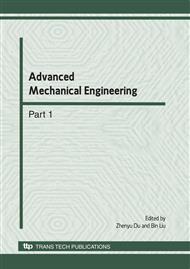[1]
S.N. Liu, Z.M. Zhang, X.T. Tian etc. Knowledge discovery method for typical process sequence based on clustering analysis. Computer Integrated Manufacturing Systems. 2006. 12: 996-1001.
Google Scholar
[2]
Kendra E. Moore, Askiner Gungor, Surendra M. Gupta. Petri net approach to disassembly process planning for products with complex AND/OR precedence relationships. European Journal of Operational Research. 2001. 135: 428-449.
DOI: 10.1016/s0377-2217(00)00321-0
Google Scholar
[3]
F.S.Y. Wong, K.B. Chuah, P.K. Venuvinod. Automated inspection process planning: Algorithmic inspection feature recognition, and inspection case representation for CBR. Robotics and Computer-Integrated Manufacturing. 2006. 22: 56-68.
DOI: 10.1016/j.rcim.2005.02.005
Google Scholar
[4]
C.F. Yuen, S.Y. Wong, Patri K. Venuvinod. Development of a generic computer-aided process planning support system. Journal of Materials Processing Technology. 2003. 139: 394-401.
DOI: 10.1016/s0924-0136(03)00507-7
Google Scholar
[5]
L. Li, J.Y.H. Fuh, Y.F. Zhang, A.Y.C. Nee. Application of genetic algorithm to computer-aided process planning in distributed manufacturing environments. Robotics and Computer-Integrated Manufacturing. 2005. 21: 568-578.
DOI: 10.1016/j.rcim.2004.12.003
Google Scholar
[6]
Turkay Dereli, I. Huseyin Filiz. Optimization of process planning functions by genetic algorithms. Computers & Industrial Engineering. 1999. 36: 281-308.
DOI: 10.1016/s0360-8352(99)00133-3
Google Scholar
[7]
Z.B. Wang, Juan Xu, Y.Z. Zhang etc. Intelligent CAPP Systems and Its Dynamic Decision for Manufacturing Resources. Journal of China University of Mining & Technology. 2006. 35: 317-322.
Google Scholar
[8]
Chiung Moon, Yoonho Seo. Evolutionary algorithm for advanced process planning and scheduling in a multi-plant. Computers & Industrial Engineering. 2005. 48: 311-325.
DOI: 10.1016/j.cie.2005.01.016
Google Scholar
[9]
Ying Tian, P.Y. Jiang, G.H. Zhou etc. Research on part multiple process routs decision-making based on ant colony algorithm. Computer Integrated Manufacturing Systems. 2006. 12: 882-887.
Google Scholar
[10]
X.G. Ming, K.L. Mak. Intelligent approaches to tolerance allocation and manufacturing operations selection in process planning. Journal of Materials Processing Technology. 2001. 117: 75-83.
DOI: 10.1016/s0924-0136(01)01154-2
Google Scholar
[11]
F.L. Zhao, S.K. Tso, Paul S.Y. Wu. A cooperative agent modeling approach for process planning. Computers in Industry. 2000. 41: 83-77.
DOI: 10.1016/s0166-3615(99)00012-3
Google Scholar
[12]
H.Z. Jia, S.K. Ong, J.Y.H. Fuh, etc. An adaptive and upgradable agent-based system for coordinated product development and manufacture. Robotics and Computer-Integrated Manufacturing. 2004. 20: 79-90.
DOI: 10.1016/j.rcim.2003.08.001
Google Scholar
[13]
B. Eynard, T. Gallet, P. Nowak, etc. UML based specifications of PDM product structure and workflow. Computers in Industry. 2004. 55: 301-316.
DOI: 10.1016/j.compind.2004.08.006
Google Scholar
[14]
C. Choppy, G. Reggio. A UML-based approach for problem frame oriented software development. Information and Software Technology. 2005. 47: 929-954.
DOI: 10.1016/j.infsof.2005.08.006
Google Scholar


